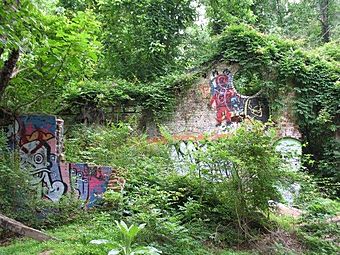Decatur Waterworks facts for kids
Quick facts for kids |
|
|
Decatur Waterworks
|
|

Part of the Decatur Water Works
|
|
| Location | 1400 McConnell Dr., Mason Mill Park, Decatur, Georgia |
|---|---|
| Area | 42 acres (17 ha) |
| Built | 1906 |
| NRHP reference No. | 06000123 |
| Added to NRHP | March 15, 2006 |
The Decatur Waterworks was a special place that helped get drinking water for the city of Decatur, Georgia. It pulled water from nearby Peachtree Creek and Burnt Fork Creek. The Waterworks was finished in 1907. It stopped being used in the 1940s. Today, it is mostly in ruins and covered with graffiti. You can find the Decatur Waterworks inside Mason Mill Park, close to the city of Decatur.
Contents
Why is Decatur Waterworks a Historic Site?
On March 15, 2006, the Decatur Waterworks was added to the National Register of Historic Places. This means it is an important historical site. It was added because it was once a key place for getting water for the city. It was also part of a big government project called the Works Progress Administration (WPA). Plus, it has been used as a public park for many years.
The Story of the Decatur Waterworks
Early Days and the Mason Mill
Long ago, before the Civil War in the 1850s, a man named Ezekiel Mason built a flour mill. This mill was on the bank of Burnt Fork Creek. This creek flows into the south fork of Peachtree Creek. Mason Mill Road and Mason Mill Park are named after this old mill.
After Mr. Mason and his wife passed away, the land changed hands. Eventually, the City of Decatur bought the property. Records show that the waterworks project was finished by December 1907.
What the Waterworks Looked Like
By 1939, the Decatur Waterworks had many parts. It had two tanks to clean the water. There were also two large tanks to store the water. An office building was on site, too. Two dams helped control the water flow. One dam was on South Peachtree Creek and another on Burnt Fork Creek. You can still see the remains of these buildings today. People often call them 'the old Decatur Water Works'.
A Park for Everyone
The Decatur Waterworks provided water to the city until the 1940s. But it also became a public park in the 1930s. A government program called the Works Progress Administration (WPA) helped build fun things there. They added granite benches, cooking grills, and tables. They also built a stone bridge over Burnt Fork Creek. You can still see these things today. The stone bridge is now part of a new walking trail in the park. The WPA also built a cool stone fountain that is still there, very close to the stone bridge.
Why the Waterworks Closed
By 1941, Decatur was growing fast. The waterworks could not make enough water for everyone. It produced about 1.8 million gallons of water each day. This was no longer enough for the city's needs.
The property was then rented to DeKalb County. The county ran the waterworks and sold water to Decatur. DeKalb County used the money to build a bigger water treatment plant. This new plant got water from the Chattahoochee River. It is now called the Scott Candler Plant.
During World War II
During World War II, the Decatur Waterworks was very important. It was the only water source for a Naval Air Station. This station is now the Peachtree DeKalb Airport. It also supplied water to an Army Hospital nearby. During the war, people were not allowed to use the waterworks for fun. It was only for military use.
After the war, the land went back to the City of Decatur. The county kept running it as a backup water source. But the park area was not taken care of. People stopped using it for recreation.
Falling Apart
For a while, the old office building was used for storage. In 1951, a plan to fix up the land was voted down. The waterworks slowly fell apart. By the mid-1960s, the lakes were filling with dirt. People living nearby complained about flooding. Around 1965, the dams were blown up with dynamite. This drained the reservoirs, which were like big ponds.
What's There Today?
In 1988, the county worked with local groups. They made a plan to develop Mason Mill Park. This plan included the old waterworks land. However, the plan never got money to be built.
In 2006, the Decatur Waterworks was officially named a historic site. A new plan was made in 2008. With some money from the PATH Foundation, parts of this plan are now being built. This helps preserve the history of this important site.



